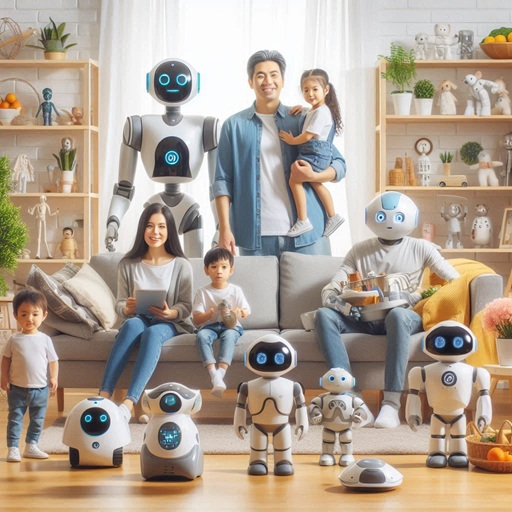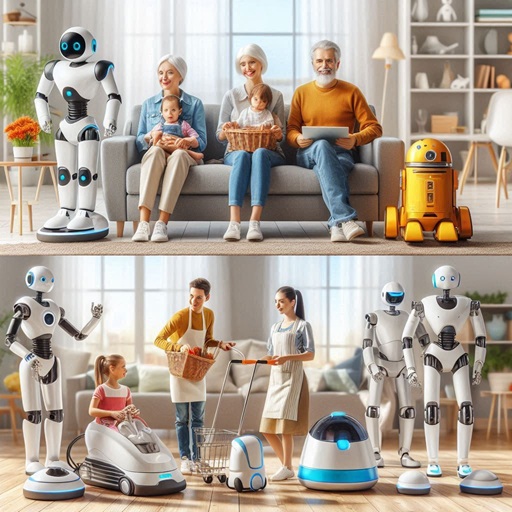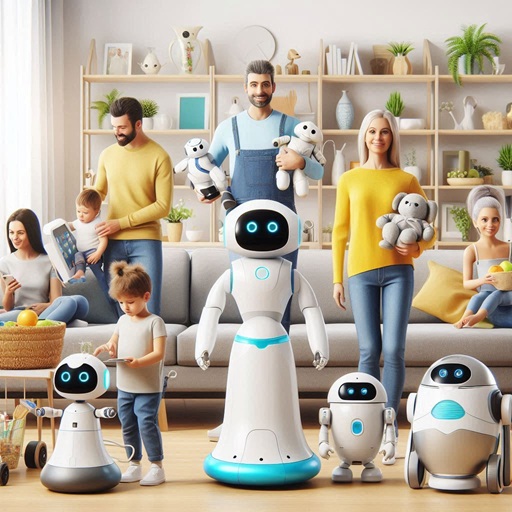The domestic robots market has witnessed exponential growth in recent years, driven by advancements in artificial intelligence (AI), machine learning (ML), and robotics technologies. Domestic robots are designed to assist humans in household tasks, ranging from cleaning and cooking to security and companionship. With the increasing adoption of smart home technologies and the growing demand for convenience, the domestic robots market is poised for significant expansion over the next decade.
What Are Domestic Robots?
Domestic robots are autonomous or semi-autonomous machines designed to perform household tasks. These robots are equipped with sensors, cameras, and AI algorithms that enable them to navigate and interact with their environment. Common types of domestic robots include:
- Vacuuming and Mopping Robots: Examples include Roomba and Roborock.
- Lawn Mowing Robots: Such as Husqvarna Automower.
- Companion Robots: Like Sony’s Aibo or SoftBank’s Pepper.
- Security Robots: Such as Ring Always Home Cam.
- Cooking Robots: Like Moley Robotics.
Market Size and Growth
The global domestic robots market is valued at USD 10.3 billion in 2023 and is projected to reach USD 24.5 billion by 2028, growing at a CAGR of 18.8% during the forecast period from 2023 to 2029.
A key opportunity for the domestic robots industry lies in enhancing the endurance capabilities of these robots. Currently, most domestic robots operate for only 1-2 hours on a full charge. Companies that focus on improving battery life and charging efficiency can gain a significant competitive advantage in the market.
Download PDF Brochure @ https://www.marketsandmarkets.com/pdfdownloadNew.asp?id=253781130
Key Trends in the Domestic Robots Market
1. Integration of AI and IoT
The integration of AI and the Internet of Things (IoT) has revolutionized the domestic robots market. AI-powered robots can learn from user behavior, adapt to different environments, and perform tasks more efficiently. IoT connectivity allows these robots to be controlled remotely via smartphones or voice assistants like Alexa and Google Assistant.
2. Rising Demand for Companion Robots
With an aging population and increasing cases of loneliness, especially in developed countries, the demand for companion robots is on the rise. These robots provide emotional support, remind users to take medications, and even engage in simple conversations.
3. Focus on Energy Efficiency
Manufacturers are increasingly focusing on developing energy-efficient domestic robots to reduce their environmental impact. Solar-powered lawn mowers and vacuum robots with longer battery life are gaining popularity.
4. Customization and Personalization
Consumers are seeking robots that can be customized to meet their specific needs. For example, vacuuming robots with adjustable suction power and mopping robots with different cleaning modes are becoming more common.
Market Segmentation
The domestic robots market can be segmented based on type, application, and region.
1. By Type
- Vacuuming and Mopping Robots
- Lawn Mowing Robots
- Companion Robots
- Security Robots
- Cooking Robots
- Others
2. By Application
- Residential
- Commercial
3. By Region
- North America
- Europe
- Asia-Pacific
- Latin America
- Middle East & Africa
Growth Drivers
1. Increasing Adoption of Smart Home Technologies
The growing popularity of smart home devices, such as smart speakers, thermostats, and lighting systems, has created a favorable environment for domestic robots. These robots can seamlessly integrate with existing smart home ecosystems, enhancing their appeal.
2. Rising Disposable Incomes
As disposable incomes rise, especially in emerging economies, consumers are more willing to invest in premium products like domestic robots that offer convenience and improve quality of life.
3. Aging Population
The global aging population is driving demand for robots that can assist with daily tasks and provide companionship. This trend is particularly prominent in countries like Japan and Germany.
4. Technological Advancements
Continuous advancements in AI, ML, and robotics are making domestic robots more intelligent, efficient, and affordable. This is encouraging wider adoption across different consumer segments.
Challenges
1. High Initial Costs
Despite their benefits, domestic robots are often expensive, which can be a barrier to adoption for price-sensitive consumers.
2. Privacy and Security Concerns
Domestic robots, especially those equipped with cameras and microphones, raise concerns about data privacy and security. Manufacturers need to address these issues to gain consumer trust.
3. Limited Functionality
While domestic robots are becoming more advanced, their functionality is still limited compared to human capabilities. This can deter some consumers from investing in these devices.
Competitive Landscape
The domestic robots market is highly competitive, with key players focusing on innovation, partnerships, and mergers to gain a competitive edge. Some of the leading companies in the market include:
- iRobot Corporation
- Samsung Electronics
- LG Electronics
- Ecovacs Robotics
- Neato Robotics
- Husqvarna Group
- Miele
- Dyson
These companies are investing heavily in R&D to develop advanced robots with enhanced features and capabilities.
The domestic robots market is expected to witness robust growth over the next decade, driven by technological advancements, increasing consumer demand, and the expansion of smart home ecosystems. Emerging markets in Asia-Pacific and Latin America are expected to offer significant growth opportunities due to rising disposable incomes and urbanization.
FAQs
1. What are domestic robots?
Domestic robots are autonomous or semi-autonomous machines designed to perform household tasks such as cleaning, cooking, security, and companionship.
2. What are the key trends in the domestic robots market?
Key trends include the integration of AI and IoT, rising demand for companion robots, focus on energy efficiency, and customization.
3. What are the challenges in the domestic robots market?
Challenges include high initial costs, privacy and security concerns, and limited functionality.
4. Who are the leading players in the domestic robots market?
Leading players include iRobot Corporation, Samsung Electronics, LG Electronics, Ecovacs Robotics, and Husqvarna Group.
5. What is the future outlook for the domestic robots market?
The market is expected to grow significantly, driven by technological advancements and increasing consumer demand, with emerging markets offering substantial growth opportunities.



